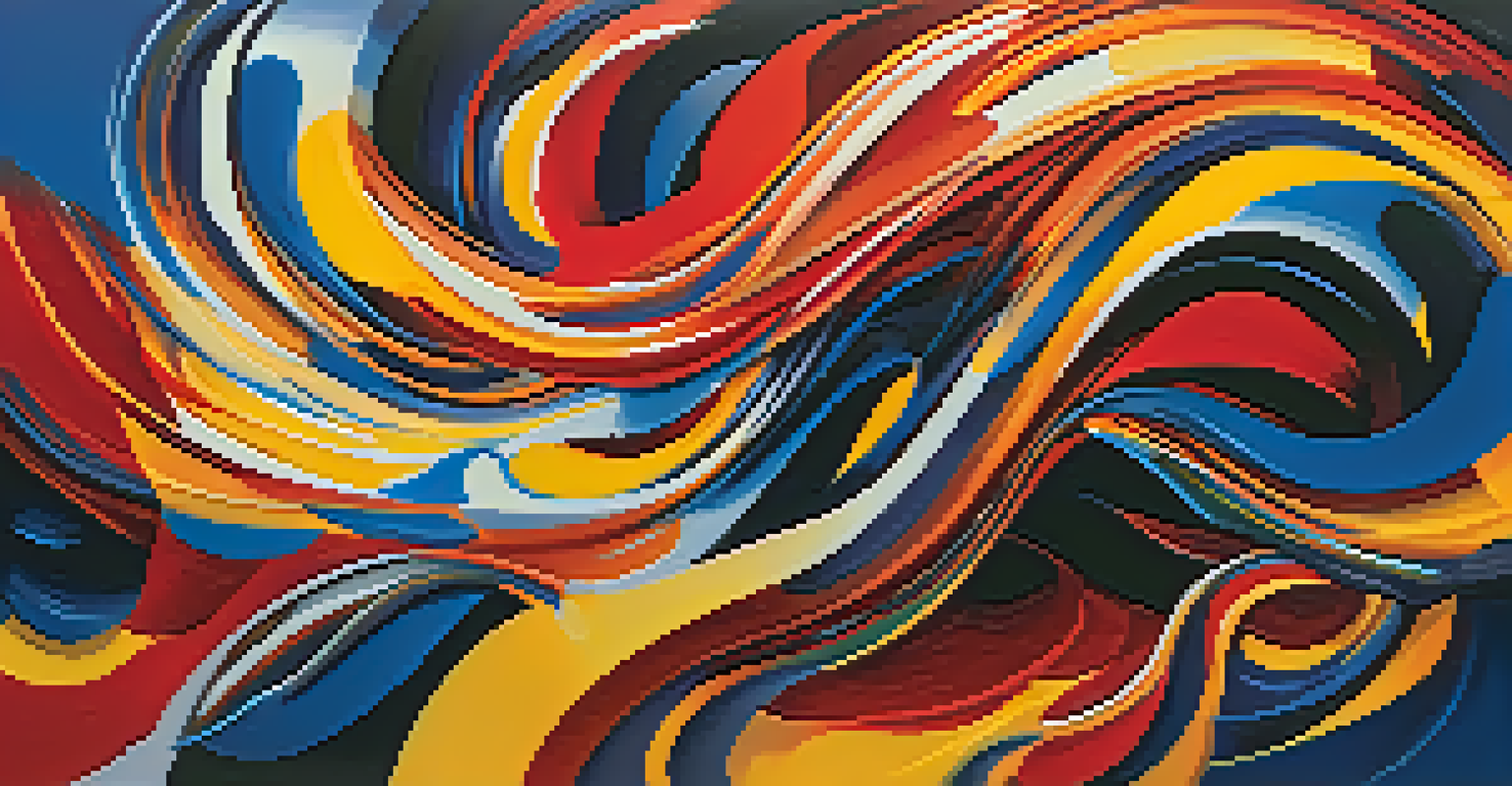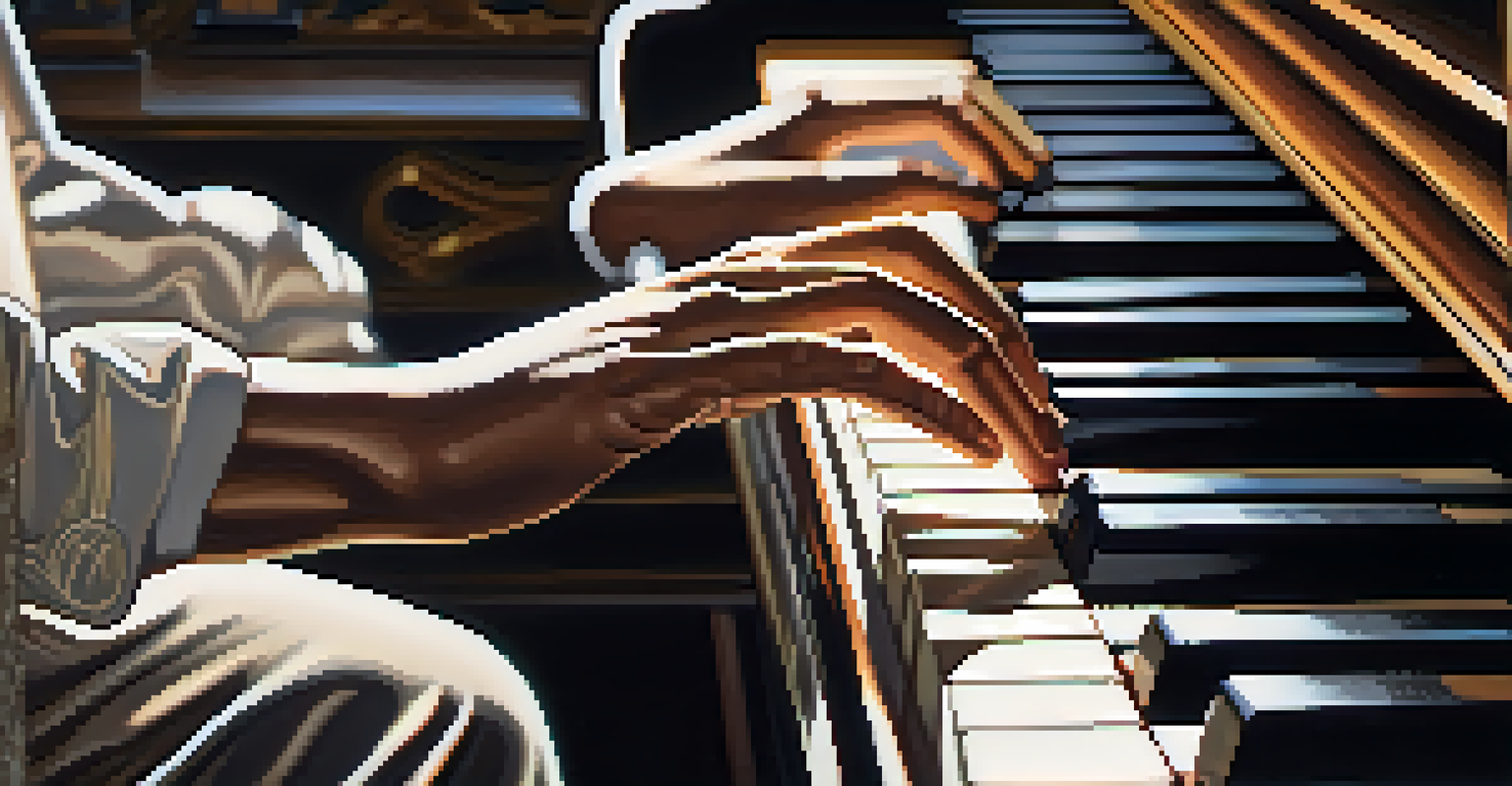Art Critique: Analyzing Music's Influence on Visual Interpretation

Understanding the Connection Between Music and Art
Music and visual art have a long-standing relationship that transcends time and culture. Both forms of expression share the ability to evoke emotions and tell stories, often complementing each other in various contexts. When we listen to music, it creates a backdrop that can influence how we perceive and interpret visual art.
Music is the shorthand of emotion.
This connection is not just anecdotal; studies have shown that music can alter our emotional responses to artworks. For instance, a serene piece may enhance the appreciation of a tranquil landscape painting, while an upbeat tune might energize our interpretation of a vibrant abstract piece. This interplay highlights the powerful role that sound plays in shaping our visual experiences.
Understanding this symbiotic relationship opens new avenues for artists and audiences alike. By exploring how music influences our perception of visual art, we can deepen our appreciation of both mediums and create richer, more immersive experiences.
Historical Influences of Music on Visual Arts
Throughout history, various art movements have been inspired by music, from the Romantic era to contemporary art. Artists such as Wassily Kandinsky believed that colors and forms could convey musical ideas, leading him to create visual compositions that mirrored musical rhythms. This fusion of art and music reflects a broader trend where artists draw inspiration from the auditory world.

Moreover, many visual artists have collaborated with musicians to create synesthetic experiences, where the boundaries between sound and sight blur. For example, the artist Robert Rauschenberg's performances often included live music, inviting audiences to engage with both sound and visual elements simultaneously. Such collaborations enrich the artistic experience, allowing for a more holistic interpretation.
Music Shapes Visual Art Perception
The emotional interplay between music and visual art enhances our understanding and appreciation of both forms of expression.
By examining historical examples, we can see how the interplay between music and visual art has evolved. This evolution underscores the importance of considering musical influences when critiquing visual artworks, as they often carry layers of meaning that extend beyond the canvas.
The Role of Emotion in Art and Music
Emotion is at the heart of both music and visual art, acting as the driving force behind their creation and interpretation. Just as a poignant melody can stir feelings of nostalgia or joy, a striking painting can evoke a sense of calm or turmoil. This emotional resonance is crucial in understanding how music influences our interpretation of visual art.
Art is the most beautiful of all lies.
For instance, a piece of music with a melancholic tone can guide viewers to see deeper layers of sadness in an artwork, even if the colors suggest otherwise. This emotional interplay highlights the subjective nature of art critique, as different musical pieces can elicit varied responses to the same visual stimulus. It emphasizes that our experiences with art are often shaped by the soundscapes we engage with.
This emotional connection invites us to explore our own feelings when viewing art. By reflecting on how music affects our emotional responses, we can develop a more nuanced understanding of visual interpretations.
Synesthesia: The Intersection of Sound and Sight
Synesthesia, a condition where stimulation of one sensory pathway leads to automatic experiences in another, provides a fascinating lens for examining the relationship between music and visual art. For some artists, sounds might evoke specific colors or shapes, enriching their creative process. This phenomenon illustrates how intertwined our senses can be, creating a unique perspective on artistic interpretation.
Many renowned artists and musicians have reported synesthetic experiences, where they perceive a direct connection between visual art and music. For instance, composer Olivier Messiaen famously created music that depicted specific colors, demonstrating how sound could translate into visual experiences. This intricate relationship can inform how we critique and appreciate artworks, as it reveals the deeply personal nature of artistic expression.
Historical Ties Between Art and Music
Throughout history, artists have drawn inspiration from music, leading to unique collaborations and evolving artistic expressions.
Exploring synesthesia encourages us to consider the diversity of human perception in art critique. By acknowledging these varied sensory experiences, we can appreciate the multitude of ways music influences our understanding of visual art.
How Music Genres Influence Visual Art Styles
Different music genres can significantly influence visual art styles, shaping not only the themes but also the techniques used by artists. For example, the bold and chaotic nature of punk rock has inspired artists to adopt raw, expressive brushwork in their paintings, while the elegance of classical music often leads to more refined and harmonious artworks. This genre-driven influence showcases the dynamic relationship between sound and visual representation.
Furthermore, the cultural context of music genres can inform the subject matter of visual art. Hip-hop, with its roots in urban culture, has inspired artists to explore themes of identity and social justice, translating the beats and rhythms into powerful visual narratives. This interplay highlights how the essence of a musical genre can shape the perspective and message of an artwork.
By examining these genre-specific influences, we can gain a deeper understanding of how music shapes visual art. This insight enriches our critique, allowing us to appreciate the layers of meaning that arise from the fusion of different artistic forms.
The Impact of Technology on Music and Visual Art
Technology has transformed the way we create and experience both music and visual art, paving new avenues for exploration and collaboration. Digital tools enable artists to incorporate sound into their visual works in innovative ways, such as creating interactive installations that respond to musical elements. This technological fusion invites audiences to engage with art on multiple sensory levels.
Moreover, music streaming platforms and social media have broadened the reach of both artists and musicians, allowing for cross-pollination of ideas. Visual artists can now showcase their work alongside curated soundtracks, creating a multi-dimensional experience for viewers. This convergence of technology, music, and visual art offers fresh perspectives and challenges traditional modes of critique.
Technology Transforms Art Experiences
Advancements in technology allow for innovative integrations of music into visual art, creating multi-sensory experiences for audiences.
As we navigate this technological landscape, it's essential to consider how these advancements influence our understanding of art. By embracing the role of technology, we can enrich our critiques and expand our appreciation of the evolving relationship between music and visual interpretation.
Conclusion: Embracing the Harmony Between Music and Art
In conclusion, the interplay between music and visual art is a rich tapestry of emotional, historical, and sensory experiences. Understanding this relationship enhances our critiques of visual art, allowing us to appreciate the complexities that arise from musical influences. By embracing this harmony, we can cultivate a more profound connection with both art forms.
As audiences, we are invited to explore how our own musical preferences shape our interpretations of visual artworks. This exploration can lead to a more personal and engaging experience with art, fostering a deeper appreciation for both the artist's intention and our own emotional responses.

Ultimately, recognizing the influence of music on visual art invites us to celebrate creativity in all its forms. As we continue to explore this dynamic relationship, we open ourselves to new ways of seeing and experiencing the world around us.